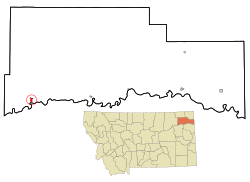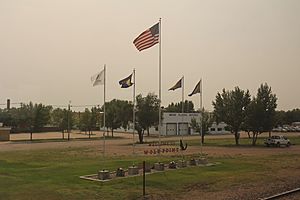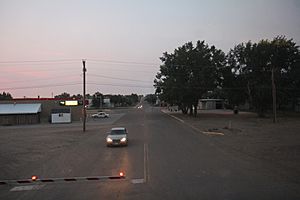Wolf Point, Montana facts for kids
Quick facts for kids
Wolf Point
|
|
|---|---|

Downtown Wolf Point
|
|

Location of Wolf Point, Montana
|
|
| Country | United States |
| State | Montana |
| County | Roosevelt |
| Incorporated (city) | 1915 |
| Government | |
| • Type | Tribal |
| Area | |
| • Total | 0.88 sq mi (2.29 km2) |
| • Land | 0.88 sq mi (2.29 km2) |
| • Water | 0.00 sq mi (0.00 km2) |
| Elevation | 2,001 ft (610 m) |
| Population
(2020)
|
|
| • Total | 2,517 |
| • Density | 2,850.51/sq mi (1,100.95/km2) |
| Time zone | UTC−7 (Mountain Standard Time (MST)) |
| • Summer (DST) | UTC−6 (Mountain Daylight Time (MDT)) |
| ZIP code |
59201
|
| Area code(s) | 406 |
| FIPS code | 30-81475 |
| GNIS feature ID | 2412291 |
| Website | http://ci.wolf-point.mt.us/ |
Wolf Point is a city in Montana, United States. It is the main town, or county seat, of Roosevelt County. In 2020, about 2,517 people lived there.
Wolf Point is the biggest community on the Fort Peck Indian Reservation. It is famous for its yearly Wild Horse Stampede. This event happens every July and is Montana's oldest rodeo. People even call it the "Grandaddy of Montana Rodeos"! Wolf Point also hosts the Wadopana Pow-wow. This is Montana's oldest traditional pow wow and takes place every August.
Contents
History of Wolf Point
Wolf Point started as a trading post in the 1860s. It was located where Wolf Creek meets the Missouri River. Farming began here as early as 1874. Early pioneers like Philip "Sandy" Knorr and John Winn planted the first crops in this part of Montana.
The Great Northern Railway arrived in 1887. This helped the town grow. Wolf Point officially became a city in 1915. It then became the county seat in 1919.
Geography and Climate
Where is Wolf Point Located?
Wolf Point is in northeastern Montana. It sits in the wide valley of the Missouri River. The city is on the north bank of the river. The downtown area is in the lower part of the city. The northern part is on low hills that look over a flat area.
What is the Climate Like?
Wolf Point has a semi-arid climate. This means it has dry winters and hot summers. Late spring and early summer are usually the wettest times of the year.
Summers can have warm, humid air. Thunderstorms are common. Sometimes these storms can be strong, bringing hail or even tornados.
Winters are generally cold and dry. Temperatures can often drop below 0 degrees Fahrenheit. However, chinook winds sometimes bring warmer, windy weather. These winds can make temperatures rise quickly, offering a break from the cold.
| Climate data for Wolf Point, Montana (1991–2020 normals, extremes 1941–present) | |||||||||||||
|---|---|---|---|---|---|---|---|---|---|---|---|---|---|
| Month | Jan | Feb | Mar | Apr | May | Jun | Jul | Aug | Sep | Oct | Nov | Dec | Year |
| Record high °F (°C) | 60 (16) |
71 (22) |
80 (27) |
95 (35) |
102 (39) |
112 (44) |
109 (43) |
110 (43) |
107 (42) |
93 (34) |
75 (24) |
65 (18) |
112 (44) |
| Mean maximum °F (°C) | 45.1 (7.3) |
48.1 (8.9) |
66.4 (19.1) |
79.1 (26.2) |
87.3 (30.7) |
93.5 (34.2) |
98.1 (36.7) |
98.9 (37.2) |
92.9 (33.8) |
81.4 (27.4) |
64.3 (17.9) |
48.1 (8.9) |
100.8 (38.2) |
| Mean daily maximum °F (°C) | 25.4 (−3.7) |
31.1 (−0.5) |
44.9 (7.2) |
59.6 (15.3) |
69.7 (20.9) |
77.9 (25.5) |
86.9 (30.5) |
86.4 (30.2) |
75.5 (24.2) |
59.7 (15.4) |
42.7 (5.9) |
29.1 (−1.6) |
57.4 (14.1) |
| Daily mean °F (°C) | 15.7 (−9.1) |
20.7 (−6.3) |
33.5 (0.8) |
46.4 (8.0) |
56.8 (13.8) |
65.6 (18.7) |
73.0 (22.8) |
72.0 (22.2) |
61.1 (16.2) |
47.1 (8.4) |
32.2 (0.1) |
19.6 (−6.9) |
45.3 (7.4) |
| Mean daily minimum °F (°C) | 6.1 (−14.4) |
10.3 (−12.1) |
22.0 (−5.6) |
33.2 (0.7) |
43.9 (6.6) |
53.3 (11.8) |
59.1 (15.1) |
57.6 (14.2) |
46.7 (8.2) |
34.5 (1.4) |
21.6 (−5.8) |
10.1 (−12.2) |
33.2 (0.7) |
| Mean minimum °F (°C) | −21.9 (−29.9) |
−14.6 (−25.9) |
−4.8 (−20.4) |
14.7 (−9.6) |
27.4 (−2.6) |
40.7 (4.8) |
47.9 (8.8) |
43.3 (6.3) |
28.8 (−1.8) |
13.1 (−10.5) |
−0.8 (−18.2) |
−13.5 (−25.3) |
−28.5 (−33.6) |
| Record low °F (°C) | −57 (−49) |
−47 (−44) |
−42 (−41) |
−10 (−23) |
6 (−14) |
26 (−3) |
32 (0) |
30 (−1) |
8 (−13) |
−10 (−23) |
−26 (−32) |
−44 (−42) |
−57 (−49) |
| Average precipitation inches (mm) | 0.41 (10) |
0.27 (6.9) |
0.46 (12) |
0.91 (23) |
2.10 (53) |
3.54 (90) |
1.81 (46) |
1.81 (46) |
1.40 (36) |
0.85 (22) |
0.42 (11) |
0.35 (8.9) |
14.33 (364) |
| Average precipitation days (≥ 0.01 in) | 2.8 | 2.0 | 2.5 | 3.0 | 5.6 | 8.8 | 6.0 | 4.8 | 3.9 | 3.6 | 2.7 | 2.5 | 48.2 |
| Source: NOAA | |||||||||||||
People of Wolf Point
| Historical population | |||
|---|---|---|---|
| Census | Pop. | %± | |
| 1920 | 2,098 | — | |
| 1930 | 1,539 | −26.6% | |
| 1940 | 1,960 | 27.4% | |
| 1950 | 2,557 | 30.5% | |
| 1960 | 3,585 | 40.2% | |
| 1970 | 3,095 | −13.7% | |
| 1980 | 3,074 | −0.7% | |
| 1990 | 2,880 | −6.3% | |
| 2000 | 2,663 | −7.5% | |
| 2010 | 2,621 | −1.6% | |
| 2020 | 2,517 | −4.0% | |
| U.S. Decennial Census | |||
In 2010, there were 2,621 people living in Wolf Point. The city had 952 households. About 50.5% of the people were Native American. About 42.5% were White. The rest were from other racial backgrounds or mixed races.
Many households (38.2%) had children under 18. The average age in the city was 33.7 years.
Fun Things to Do
Wolf Point has some interesting places to visit:
- The Silverwolf Casino is run by the Sioux and Assiniboine tribes.
- The Wolf Point Area Museum teaches about the local history.
The Roosevelt County Library has its main branch in Wolf Point. It also has smaller branches in nearby towns.
Education in Wolf Point
Schools for Kids and Teens
Wolf Point Public Schools has an elementary school, a middle school, and a junior/senior high school. More than 860 students attend these schools. Wolf Point High School is known as the Wolves.
There is also Frontier Elementary School nearby. It serves students from pre-kindergarten to eighth grade in some rural areas.
College Opportunities
Fort Peck Community College has a campus in Wolf Point. This college offers different programs and degrees. It also helps students get their GEDs. In 2009, the college started men's and women's basketball teams.
News and Radio
Wolf Point has two weekly newspapers: the Northern Plains Independent and the Fort Peck Journal.
There are also radio stations that serve the area. These include KVCK (AM) 1450 and KVCK-FM 92.7. The public radio station KYPW is also located in Wolf Point.
Getting Around Wolf Point
Air Travel
You can fly into Wolf Point's L. M. Clayton Airport. Cape Air offers daily flights to Billings and Glasgow, Montana.
Roads and Highways
U.S. Route 2 is a major highway that runs through Wolf Point. It connects the city to other towns across the northern states. Montana Highway 25 also connects to Montana Highway 13. Highway 13 goes from the Canadian border south to Circle.
Train Service
Wolf Point is on the BNSF Railway line. It is an important place for shipping grain. You can also take the train from Wolf Point. Amtrak's Empire Builder train stops here daily. It is the first stop west of Williston, North Dakota.
Healthcare Services
Wolf Point has several medical facilities. Trinity Hospital offers inpatient care and emergency care. It also provides many other health services. Northeast Montana Health Services (NEMHS) runs the hospital. They also operate the Faith Lutheran Home, which is a nursing facility. The Listerud Rural Health Clinic is also in Wolf Point.
The Chief Redstone Clinic is run by the Indian Health Service. It helps meet the health needs of the Native American population in the area.
Famous People from Wolf Point
- Hank Adams (1943–2020), a Native American rights activist.
- Dolly Akers, the first Native American woman elected to the Montana Legislature.
- Casey FitzSimmons (born 1980), a former National Football League player.
- John Lowenstein (born 1947), a former Major League Baseball player.
- Kameron (Kam) Mickolio (born 1984), a former Major League baseball pitcher.
- Montie Montana (1910–1998), a famous rodeo trick rider.
- Ted Schwinden (1925–2023), who was the Governor of Montana from 1981 to 1989.
See also
 In Spanish: Wolf Point (Montana) para niños
In Spanish: Wolf Point (Montana) para niños




